Psyche is the Greek term for "soul".

Till We Have Faces: A Myth Retold is a 1956 novel by C. S. Lewis. It is a retelling of Cupid and Psyche, based on its telling in a chapter of The Golden Ass of Apuleius. This story had haunted Lewis all his life, because he realized that some of the main characters' actions were illogical. As a consequence, his retelling of the story is characterized by a highly developed character, the narrator, with the reader being drawn into her reasoning and her emotions. This was his last novel, and he considered it his most mature, written in conjunction with his wife, Joy Davidman.
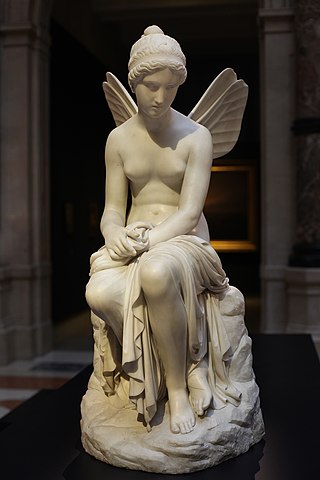
Psyche is the Greek goddess of the soul and often represented as a beautiful woman with butterfly wings. The name Psyche means "soul" in Greek and was commonly referred to as such in Roman mythology as well, though the direct translation is Anima. She was born a mortal woman and eventually granted immortality, with beauty that rivaled even Aphrodite, goddess of love. Psyche is known from the novel The Golden Ass, also known as Metamorphoses, written by the Roman philosopher and orator Apuleius in the 2nd century. In the myth, she was given multiple trials to be with her beloved, Eros, also known as Cupid, god of physical love and desire and son of Aphrodite. The cultural influences of Psyche's story can be depicted in art dating back to the 4th century BCE.
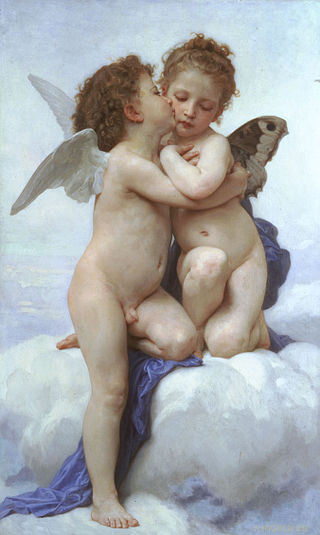
L'Amour et Psyché, enfants is an oil painting by William Adolphe Bouguereau in 1890. It is currently in a private collection. It was displayed in the Salon of Paris in 1890, the year Bouguereau was President of the Société des Artistes Français. The painting features Greek mythological figures Eros and Psyché, sharing an embrace and kiss. Bouguereau was a classical-style painter in the Neoclassical era of art. The painting is characterized by the frothy background the figures delicately stand on. It depicts the beginning of the forbidden romance of Cupid and Psyche, a popular subject at the time of execution.
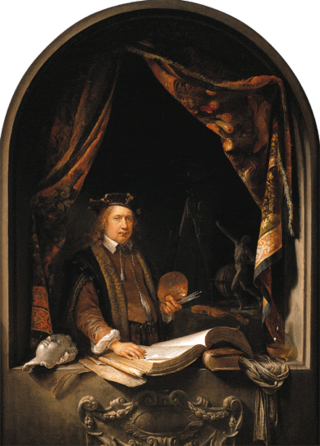
Gerrit Dou, also known as GerardDouw or Dow, was a Dutch Golden Age painter, whose small, highly polished paintings are typical of the Leiden fijnschilders. He specialised in genre scenes and is noted for his trompe-l'œil "niche" paintings and candlelit night-scenes with strong chiaroscuro. He was a student of Rembrandt.

The Metamorphoses of Apuleius, which Augustine of Hippo referred to as The Golden Ass, is the only ancient Roman novel in Latin to survive in its entirety.
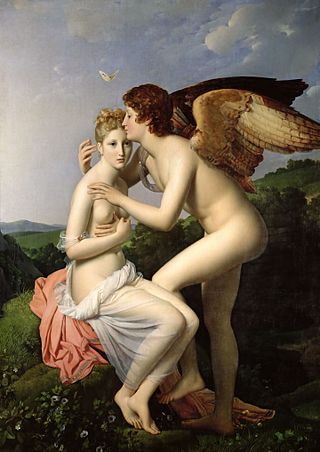
Cupid and Psyche is a story originally from Metamorphoses, written in the 2nd century AD by Lucius Apuleius Madaurensis. The tale concerns the overcoming of obstacles to the love between Psyche and Cupid or Amor, and their ultimate union in a sacred marriage. Although the only extended narrative from antiquity is that of Apuleius from 2nd century AD, Eros and Psyche appear in Greek art as early as the 4th century BC. The story's Neoplatonic elements and allusions to mystery religions accommodate multiple interpretations, and it has been analyzed as an allegory and in light of folktale, Märchen or fairy tale, and myth.
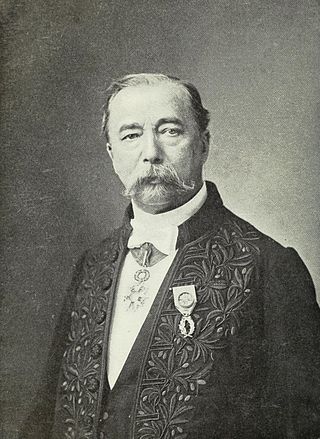
Jules Joseph Lefebvre was a French painter, educator and theorist.
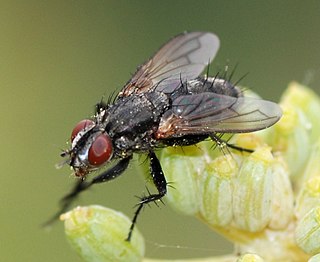
Rhinophorinae is a subfamily of flies (Diptera), commonly known as Woodlouse Flies, found in all zoogeographic regions except Oceania, but mainly in the Palaearctic and Afrotropical regions.

Marie-Guillemine Benoist, born Marie-Guillemine Laville-Leroux, was a French neoclassical, historical, and genre painter.

"To Helen" is the first of two poems to carry that name written by Edgar Allan Poe. The 15-line poem was written in honor of Jane Stanard, the mother of a childhood friend. It was first published in the 1831 collection Poems of Edgar A. Poe. It was subsequently reprinted in the March 1836 issue of the Southern Literary Messenger. The final, revised version appeared in the 1845 collection The Raven and Other Poems.
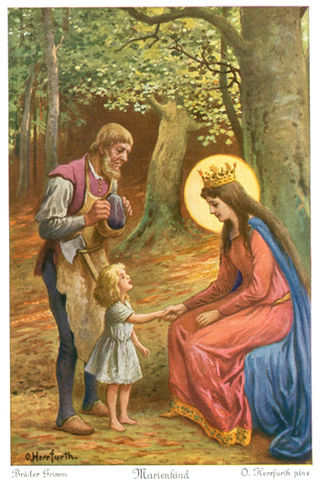
"Mary's Child" is a German fairy tale collected by the Brothers Grimm in Grimm's Fairy Tales in 1812. It is of Aarne-Thompson type 710.

Lygia Pape was a Brazilian visual artist, sculptor, engraver, and filmmaker, who was a key figure in the Concrete movement and a later co-founder of the Neo-Concrete Movement in Brazil during the 1950s and 1960s. Along with Hélio Oiticica and Lygia Clark, she was an important artist in the expansion of contemporary art in Brazil and pushed geometric art to include aspects of interaction and to engage with ethical and political themes.
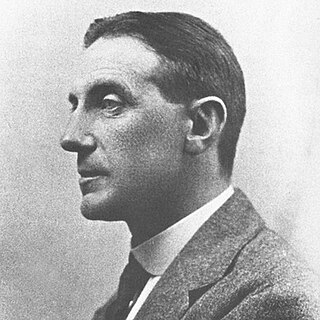
Francis Cheyne Papé, was an English artist and illustrator whose career spanned 64 years, from 1898 to 1962. Papé's work included painting using gouache, water colour, and illustration in pen and ink.
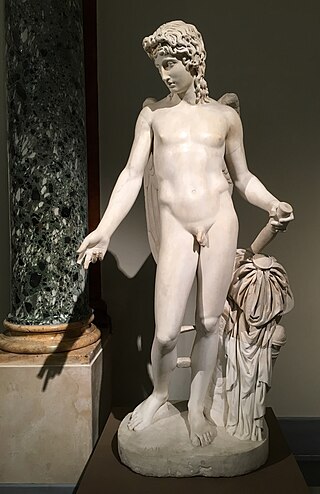
In Greek mythology, Eros is the Greek god of love and sex. His Roman counterpart is Cupid ('desire'). In the earliest account, he is a primordial god, while in later accounts he is described as one of the children of Aphrodite and Ares and, with some of his siblings, was one of the Erotes, a group of winged love gods.

The marble Cupid and Psyche conserved in the Capitoline Museums, Rome, is a 1st or 2nd century Roman copy of a late Hellenistic period original. It was given to the nascent Capitoline Museums by Pope Benedict XIV in 1749, shortly after its discovery. Its graceful balance and sentimental appearance made it a favourite among the neoclassical generations of artists and visitors, and it was copied in many materials from bronze to biscuit porcelain. Antonio Canova consciously set out to outdo the Antique original with his own Cupid and Psyche of 1808

Love and Psyche or Cupid and Psyche is an 1817 painting by Jacques-Louis David, now in the Cleveland Museum of Art. It shows Cupid and Psyche. It was produced during David's exile in Brussels, for the patron and collector Gian Battista Sommariva. On its first exhibition at the museum in Brussels, it surprised viewers with its realist treatment of the figure of Cupid. Critics generally saw the painting's unconventional style and realistic depiction of Cupid as proof of David's decline while in exile, but art historians have come to see the work as a deliberate departure from traditional methods of representing mythological figures.
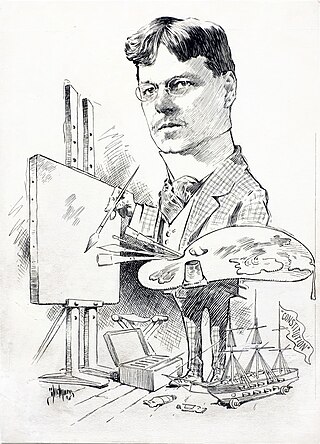
Frederic L. Pape, known as Eric Pape, was an American painter, engraver, sculptor, and illustrator.
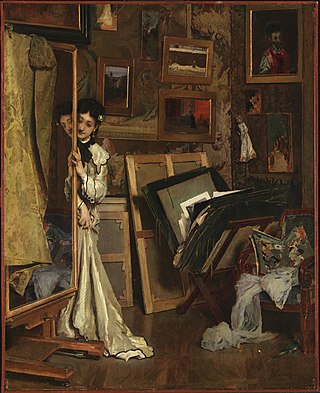
The Psyché is an oil on panel painting by the Belgian artist Alfred Stevens. Painted in circa 1871, the painting once belonged to Robert de Montesquiou, and is currently housed at the Princeton University Art Museum located in Princeton, New Jersey.

The Psyche Mirror, original French title La Psyché, is an oil-on-canvas painting by the French artist Berthe Morisot, created in 1876. The painting links the theme of a woman making her toilet with the mythical motif of Psyche. The work is held in the Thyssen-Bornemisza Museum, in Madrid.



















